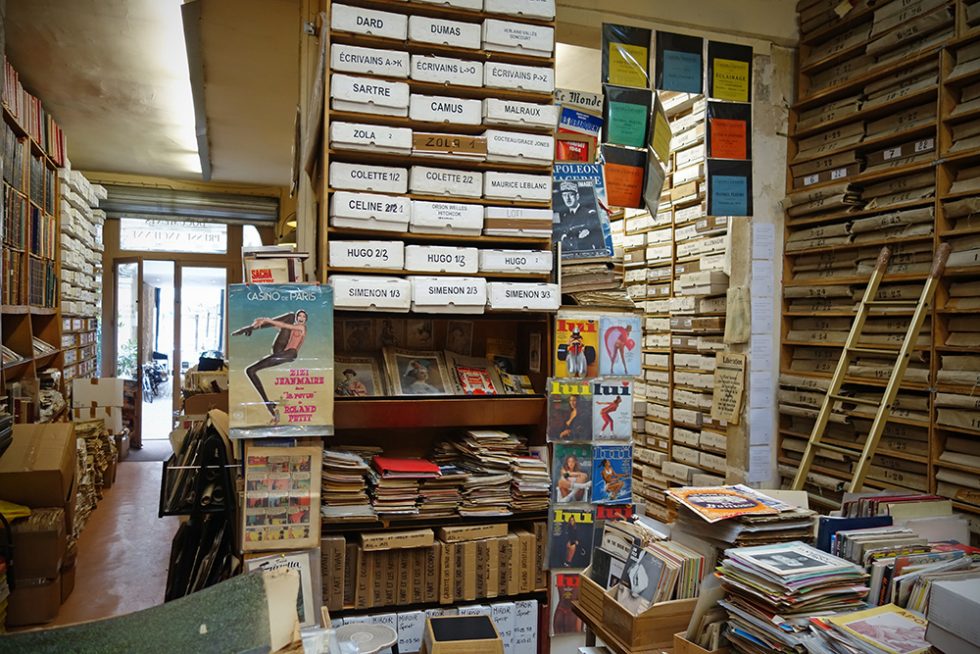-

There are many hidden courtyards in Paris, many of which are open to the curious wanderer. On Rue de l’bare Sec, in the middle of Paris, there’s an archway that leads to a small cobblestone courtyard and then into a wonderful world of printed treasure called La Galcante.
Founded back in 1975 by Christian Bailly, Chairman of Musée de la Presse, La Gallant was a small shop that sold copies of the Museum’s collections. Today, the shop holds over seven million copies of various French newspapers, magazines, and other publications and documents dating as far back as the fifteenth century.
When I visited I spoke with Peter, a member of staff who was happy to talk with me about the history of the shop that actually expands into areas where the general public cannot go. He shows me a basement full of boxes and tells me that in Normandy they have a warehouse full of yet more material.
It’s an impressive and quite mesmerizing collection of printed material that gives the casual browser a beautiful glimpse into everydays of times that have faded from memory but are remembered in print.
I browse through color magazines from the 1950s, enjoying the advertisements for objects that make me realize how quickly our phones, computers, and gadgets of today will seem almost comical to the generations of tomorrow.
I ask Peter what kind of people come to the shop. He lights a cigarette takes a moment to enjoy the first draw of smoke then tells me in his deep French accent that there are three kinds of customers.
“We see professionals of cinema and TV. They mostly rent things for props. Then there are the birthdate and anniversary newspaper sales, this was invented here. And the third kind of customer are the people who want to find everything else.”
Indeed, it seems that ‘everything else’ might very well be found somewhere on the musty archived shelves of this enchanting shop where time is more of a location that can be visited rather than a point in history.
It’s clear to me that Peter enjoys talking about La Gallant and the work he does. Such job satisfaction is perhaps rare to find in a country famous for its summer strikes that regularly bring transport and services to a grinding halt each year.
“I’m very proud to say that in the movie Hugo Cabaret by Martin Scorsese, all the newspapers that you see in the train station were chosen by me. So there is a little of me in a Scorsese film.” Peter tells me.
I ask him how he feels about digital archiving. He shrugs his shoulder and takes a long slow drag from his cigarette, “Well why not?” With that, he walks me to another part of the shop and takes a piece of paper out of a plastic wrap that was pinned to the wall behind the counter.
He waves it around and manipulates it without precaution to demonstrate its durability. Handing it to me he invites me to feel the quality of the paper. It’s rough to touch but flexible and thick, more like canvas and quite unlike any paper from today.
“You can feel that it is almost not completely dry,” he says as I handle the obviously old document. “The paper needs humidity, otherwise it will become like dust.”
Then he performs the reveal to this trick that I feel he has done on more than one occasion. He turns the page over and reveals to me the date printed the document. September 2nd, 1784! My shock and amazement is obvious. While receipts of purchases I made but a few days ago fade to pieces of blank paper in my wallet, 1784 is in my hand and it looks much the same today as it would have more than two hundred years ago.
“In the early 1980’s they told us that the CD would last for more than a lifetime, but try to play those CDs now,” Peter says, and his point is well made.
With his cigarette casually clasped between his fingers, he turns and pins the ancient document to its unassuming place on the wall once more.
“In a world where everybody throws things away, we keep,” he says. “We are a bit crazy. We have to be!”
—
Find the archway leading to La Galcante using Google street view
